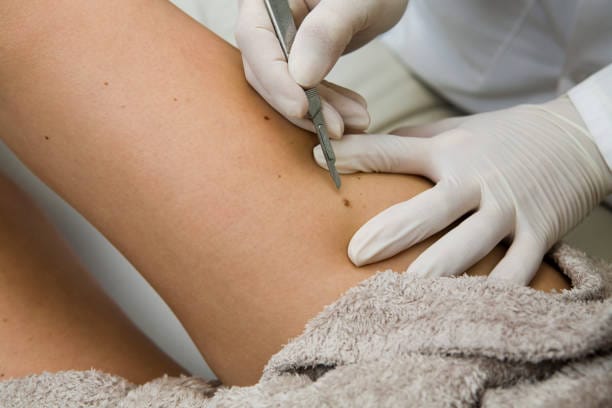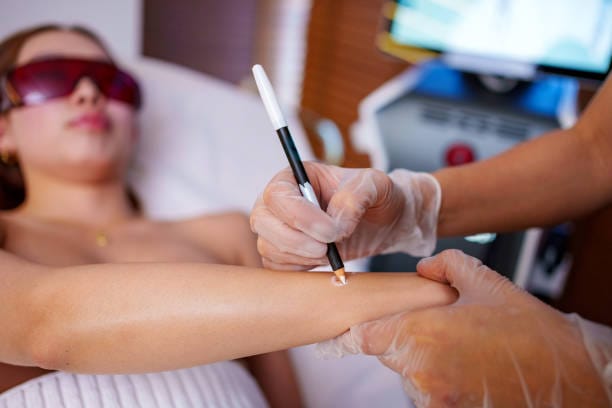Mole Removal for Different Skin Types: What You Need to Know

Mole Removal for Different Skin Types
Moles are common skin growths on the body chose wisely Mole Removal for Different Skin Types. Most are harmless, but many still decide to have them removed for cosmetic or health reasons. Most people have no problem with mole removal treatments, but not all skin types are the same. Factors such as oiliness, dryness, sensitivity, and pigmentation risks determine the kind of removal and aftercare.
If you choose a treatment that does not suit your skin type, you may itch and become hyperpigmented. Therefore, you must learn about different Mole removal methods for various skin types.
Here, we will discuss Mole removal for different skin types, the perfect treatment options available, and aftercare tips to avoid scars and discoloration.
Knowing What Effect On Mole Removal for Different Skin Types
It is important to understand that not all mole removal procedures are the same, and the key to how your skin reacts depends on your skin type. Some skin types will heal fast with little scarring, while others tend to respond to irritation, dryness, or hyperpigmentation. Learning your skin type also allows you to determine the safest and most effective mole removal method.
1. Normal Skin
Luckily, if you have normal skin, your skin should heal well after removing a mole. It is a balanced skin type with proper amounts of oil and moisture, decreasing the chance of getting too dry or irritated. Laser or surgical mole removal is good because they have little risk of complications.
Best treatments for normal skin:
- Laser mole removal for precise removal with minimal damage.
- Surgical excision for larger or deeper moles.
- Surgeons use cryotherapy if the mole is small and superficial.
2. Oily Skin
The skin produces Extra sebum, which slows healing and increases the chances of infection or clogged pores. If you have acne-prone skin, selecting the proper mole elimination method is vital to avoiding acne.
Challenges of mole removal for oily skin:
- Increased risk of post-procedure acne or breakouts.
- Treatment may cause more skin oil.
- There is a risk if care is not properly followed aftercare.
Best treatments for oily skin:
- It causes minimum trauma to the skin
- Helps in controlling the extra oil and bacteria: electrosurgery.
- Do not practice cryotherapy to prevent irritation and overproduction of oil.
3. Dry Skin
A person with dry skin will also experience flaking, irritation, and slow healing of wounds. Proper moisturisation is crucial for preventing scars once mole removal can cause dryness in more places, and the latter thus must be dealt with.
Challenges of mole removal for dry skin:
- More prone to cracking and irritation afterward.
- The healing process is slow and leads to the formation of a scab.
- After mole removal, the skin may be red or flaky.
Best treatments for dry skin:
- Surgical excision, with a focus on proper moisturisation afterward.
- Harsh chemical treatments should also be avoided to reduce the dryness even more.
4. Sensitive Skin
Mole removal on sensitive skin induces redness, inflammation, and irritation. If treated improperly, the skin can become very sensitive and irritated, burning, having excessive scars, or even prolonged redness
Challenges of mole removal for sensitive skin:
- Higher risk of Redness, swelling, and irritation.
- Increased risk of post-inflammatory hyperpigmentation (PIH).
- Some treatments may cause burning and itching.
Best treatments for sensitive skin:
- As it’s gentle and precise, laser mole removal is ideal.
- Cryotherapy, but only with controlled application.
- Never use aggressive excision methods as they might lead to skin irritation.
5. Combination Skin
Combination skin generally has oily and dry areas, so a balanced mole removal approach is required. The cheeks and jawline may be the driest places, although the T zone (forehead, nose, chin) may be oilier.
Challenges of mole removal for combination skin:
- Targeted aftercare in different areas of the face.
- Risk of clogged pores in oily zones after the course of treatment.
- Flaking or irritation may occur in the affected dry area.
Best treatments for combination skin:
- It is laser mole removal, which works well for oily and dry areas.
- Dry areas requiring surgical removal - and then lathering post-care
6. Dark vs. Light Skin Tones
Mole removal also depends on skin tone because hyperpigmentation risks are very important. Lighter people may experience redness or scarring, while darker skin tones are more likely to develop post-inflammatory hyperpigmentation (PIH).
Challenges of mole removal for dark skin:
- There is a high risk of hyperpigmentation or dark spots after mole removal.
- The darker your skin tone is, the more likely you will get keloid scarring.
- Laser treatments must be adjusted so that the burns or discoloration don't occur.
Best treatments for dark skin:
- Controlled removal is provided by surgical mole removal.
- The right setting of laser treatments to avoid pigmentation problems.
- Don’t get aggressive cryotherapy, which can cause white patches.
Challenges of light Mole Removal for Different Skin Types
Redness or scarring will be more visible after the procedure, as portable light treatment is less powerful than a dermatologist’s office procedure.
Skin may be reactive to heat-based treatments.
Best treatments for light skin:
- Blur Laser mole removal is a good choice for fair skin tones.
- Since lighter skin is less susceptible to hypopigmentation, cryotherapy.
Best Mole Removal Methods for Different Skin Types
How your skin reacts to treatments determines whether or not you should use a certain mole removal method. The intention is to remove the mole without injury, effect on pigmentation, or irritation. Here, we outline the most efficient ways to rid yourself of those grown moles and secure them, using the most suitable method for different skin types.

1. Laser Option Of Mole Removal for Different Skin Types
Laser mole removal is one of the most advanced methods for people who do not want scarring. It involves a high-energy laser breaking the mole’s pigment apart so the body can absorb and remove it naturally.
- Best for:
It heals quickly with little after-effect.
For the risk of clogged pores
Non-invasive and gentle but may cause temporary redness.
Less risk of pigmentation if the proper settings on the laser are used
- Not ideal for:
It can lead to temporary flakiness and very dry skin.
As laser removal is best for flat or small pigmented moles, large, raised moles, as you describe them, are best treated with laser typing and removal.
2. Surgical Excision: Best for Large or Suspicious Moles
A more old-school method of surgical mole removal is where a dermatologist cuts out the mole with a scalpel and stitches the area. Moles that are large, deep, or might be cancerous are often recommended for.
- Best for:
It will heal well if properly cared for afterward
If moisturization is maintained after surgery, it works fine for dry skin
Less noticeable scars
- Not ideal for:
It can break out or heal slowly because of too much oil if you have oily skin
Keloid scarring due to a higher risk of dark skin tones.
3. Cryotherapy Mole Removal for Different Skin Types
In cryotherapy mole removal, liquid nitrogen freezes and destroys mole cells. The mole eventually scabs over and falls off on its own. This is the best method for smaller, superficial, and non-cancerous moles.
- Best for:
They avoid hypopigmentation — which is easier when your skin tone is light
Since they heal relatively fast, they are good for normal and oily skin.
- Not ideal for:
It can also leave pigmentation in pigmentation-prone skin types that may not fade.
Since freezing can cause excessive redness or irritation on sensitive skin.
4. Electrosurgery Mole Removal for Different Skin Types
Electrosurgery involves using high-frequency electrical currents to burn off the mole layer by layer. It is often combined with scraping to remove the mole completely.
- Best for:
It also helps to reduce bacteria if your skin is oily and acne-prone.
It heals without major problems.
- Not ideal for:
Dry and sensitive skin due to the risk of redness and prolonged healing.
It may leave hyperpigmentation or scarring and works best with darker skin tones.
5. Shave Excision
This method involves shaving the mole at the surface level with a special blade. It takes very little time and does not involve stitches, making it a nice option for a speedy recovery desired by those who want minimal downtime.
- Best for:
Skin-colored raised moles that do not extend deep into the skin.
It heals relatively well and better on normal and combination skin.
- Not ideal for:
If you have sensitive skin, the process may be uncomfortable.
For dark skin tones, there’s a chance of post-inflammatory hyperpigmentation.
Which Method Is Right Mole Removal for Different Skin Types?
- And for oily skin, you are better off with laser or electrosurgery to avoid blocked pores.
- If you have dry or sensitive skin, go for laser mole removal to prevent a painful treatment.
- Cryotherapy and electrosurgery are dangerous for dark skin tones because they may cause pigmentation issues.
- The safest option is surgical excision for larger or deeper moles.
Post-Treatment Care Mole Removal for Different Skin Types
Regardless of the type of mole removal you opt for, you must take good care after the procedure to help heal, prevent scarring, and regain good skin health. The care used for different skin types varies but helps prevent infection, irritation, or discoloration.
1. Aftercare for Normal Skin: Simple and Effective Healing Mole Removal for Different Skin Types
In most cases, normal-skinned people recover smoothly after mole removal. However, simple aftercare is still needed to avoid negative consequences.
Best Practices:
- Wash the area gently with mild soap and water to keep the area clean.
- Leave the area bandaged for the first 48 hours, then breathe.
- To avoid darkening of the scar from excessive sun rays.
2. Aftercare for Oily and Acne-Prone Skin: Preventing Breakout
Blemishes typically take longer to heal if you have oily skin, as oily skin's pores are prone to clogging and breakouts. After the removal, care should be taken to keep the area clean and oil-free.
Best Practices:
- To stop the excess sebum buildup, use an oil-free cleanser.
- Avoid thick creams or ointments to prevent pores from clogging. Instead, use a lightweight antibiotic gel.
- Avoid using makeup around the treated area to prevent bacterial growth.
- It is important to change pillowcases regularly (as it keeps the area free from bacteria).
3. Aftercare for Dry Skin: Hydration Is Key
Because of a weaker skin barrier, dry skin may take longer to heal. Hydration is critical for reducing flakiness and the time it takes to recover.
Best Practices:
- Moisturize the skin gently (with fragrance-free moisturiser) to prevent drying.
- Alcohol based skincare products should be avoided since they are irritating.
- To keep skin hydrated, use a humidifier if you live in a dry climate.
- Support the skin’s natural healing by drinking plenty of water.
4. Aftercare for Sensitive Skin: Minimizing Redness and Irritation
After mole removal, people with sensitive skin could experience redness, itching or long-lasting irritation. It is necessary to approach gently to avoid reactions.
Best Practices:
- Clean the area with a fragrance-free and hypoallergenic cleanser.
- A dermatologist-approved healing cream or aloe vera gel will do the trick.
- Also, avoid harsh exfoliants, acids or retinoids for at least two weeks.
Walking around for a while will also be beneficial without putting any pressure on the healing area. To this end, you should wear soft, breathable fabrics.
Aftercare for Dark Skin Tones: Preventing Hyperpigmentation
Finally, PIH more often appears in darker skin tones after mole removal. Special care is required to prevent dark spots and uneven skin tone.
Best Practices:
- Use sunscreen (at least SPF 30) daily to avoid dark marks.
- To even out the healing, make use of a silicone-based scar gel.
- Picking scabs is to be avoided since it lends itself to pigmentation changes.
- If you’ve healed, vitamin C or niacinamide can brighten the area.
Healing Timeline of Mole Removal for Different Skin Types
Redness, minor swelling and scabbing may occur in the first few days.
The wound closes, and scabs will fall off in 1-2 Weeks.
No specific period: This is based on your skin type and aftercare technique.
People with delicate or dark skin tones may heal a little longer. If you want scar-free mole removal, be patient and follow the correct aftercare.
Which Procedure Is Effective for You When Going Mole Removal for Different Skin Types?

Your skin type and how it heals are the deciding factors for the best method of Mole Removal for Different Skin Types. When your skin is normal, both shave excision and surgical excision are good options since your normal skin is also likely to heal without any complications. If you have oily skin, shave excision and electrosurgery are good choices for removing raised moles, as they don’t overagitate or cause excessive irritation.
Laser removal and surgical excision are better for dry skin since they don’t dehydrate or irritate excessively. Laser removal or cryotherapy is preferred for people with sensitive skin as these procedures cause minimal discomfort.
Since dark skin is prone to hyperpigmentation and scarring, laser removal and shave excision are the best methods due to the reduced risk. Surgical procedures, such as excision, that can leave noticeable scars may often be less desirable in the body areas where the color is darker. If you are unsure which device best suits you, consulting a professional dermatologist will allow you to make a reasonable choice according to the type of your skin and mole features.
Why Choose Revitalise London Mole Removal for Different Skin Types?
When removing moles on each skin type, you should pay attention to the particulars you seek to select the right clinic and guarantee healthy, reduced, and scarless outcomes. Here at Revitalise London, we provide tailor-made mole removal treatments based on your skin type, mole size, and any personal preferences.
Advanced Techniques Mole Removal for Different Skin Types
However, our clinic offers professional mole removal methods, including laser, cryotherapy, shave, and surgical excision. We use gentle laser technology to avoid scarring and pigmentation changes in sensitive and dark skin tones. Our precise shave and electrosurgery techniques also prevent additional irritation in oily or blemished skin.
Minimising Scarring for Flawless Skin
Revitalise London is a priority for scar prevention. We offer various advanced techniques and aftercare plans to reduce scarring. Our experts are talented and experienced enough to provide personalised aftercare advice, such as how to treat your wound and sun and skin care advice to make your skin heal beautifully.
Why Patients Trust Revitalise London? Mole Removal for Different Skin Types
Safe Mole Removal by Experienced Dermatologists: Our professional helps ensure precise and safe mole removal. Treatments are varied in scope, and we use more than one, depending on skin type.
Latest Equipment: Used for scar-free results.
Aftercare: It’s all-inclusive up to maintenance with smooth, even standard skin. That’s what we believe at Revitalise London. Book now to get expert mole removal experience over minimal downtime and maximum confidence!
Conclusion: Achieve Safe and Effective Mole Removal for Different Skin Types
In other words, mole removal is not a one-size-fits-all procedure. Your skin type, mole characteristics, and personal preference will all determine which mole removal method you choose. If you choose laser removal, cryotherapy or surgical excision, you’ll make an informed choice which is safe, effective and with no scars.
We at Revitalise London have different treatments for all skin types. We specialize in mole removal treatments that suit our customers’ needs. Our expert dermatologists are dedicated to performing all procedures with precision and minimal scarring while maintaining safety. Treating it as soon as possible and following an appropriate aftercare means that you can have smooth, clear, happy skin without lingering ugly marks.
If you want professional mole removal, book an appointment with Revitalise London today. We will help you select the most suitable procedure that will not make you uncomfortable and produce flawless results.
